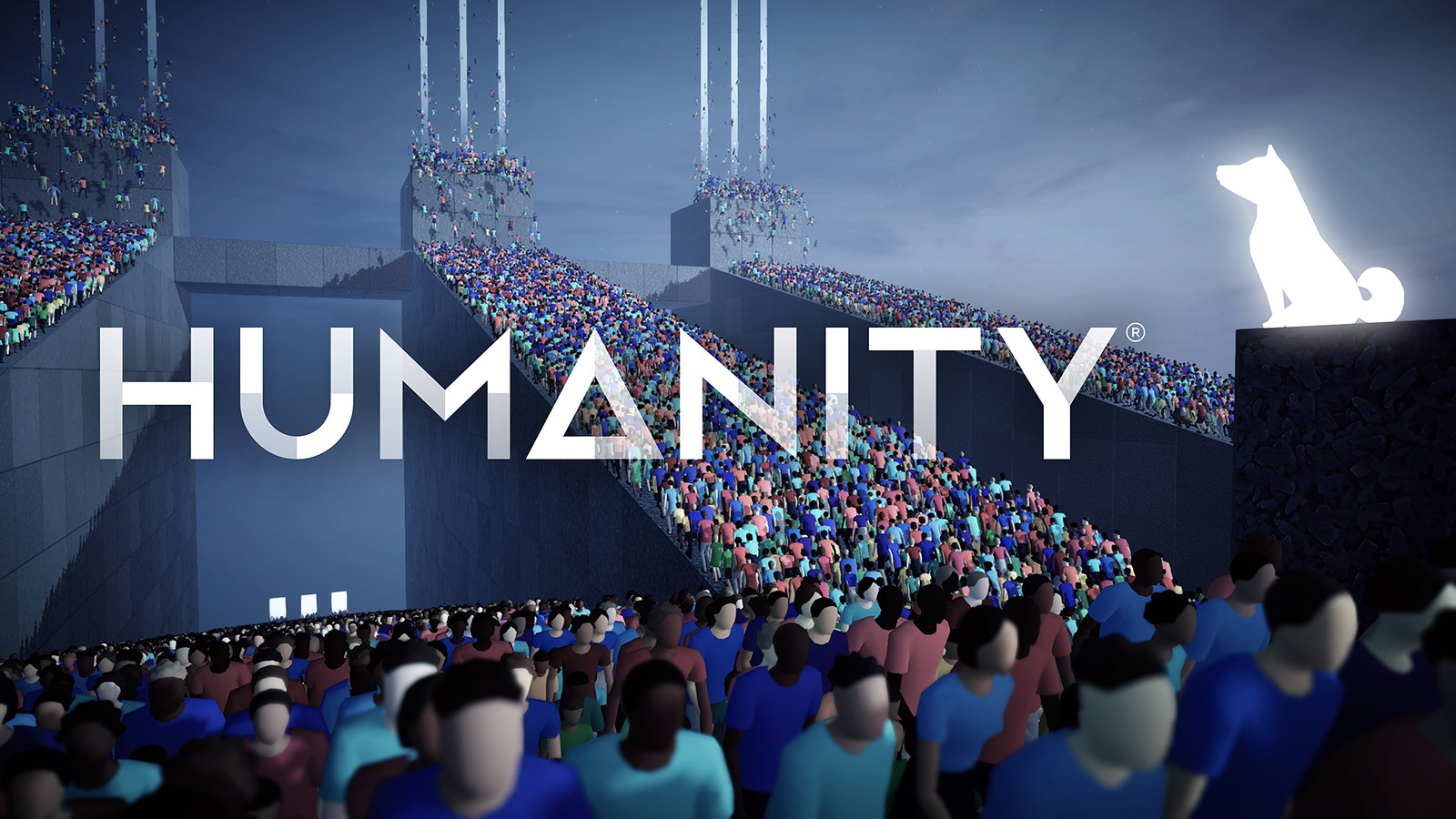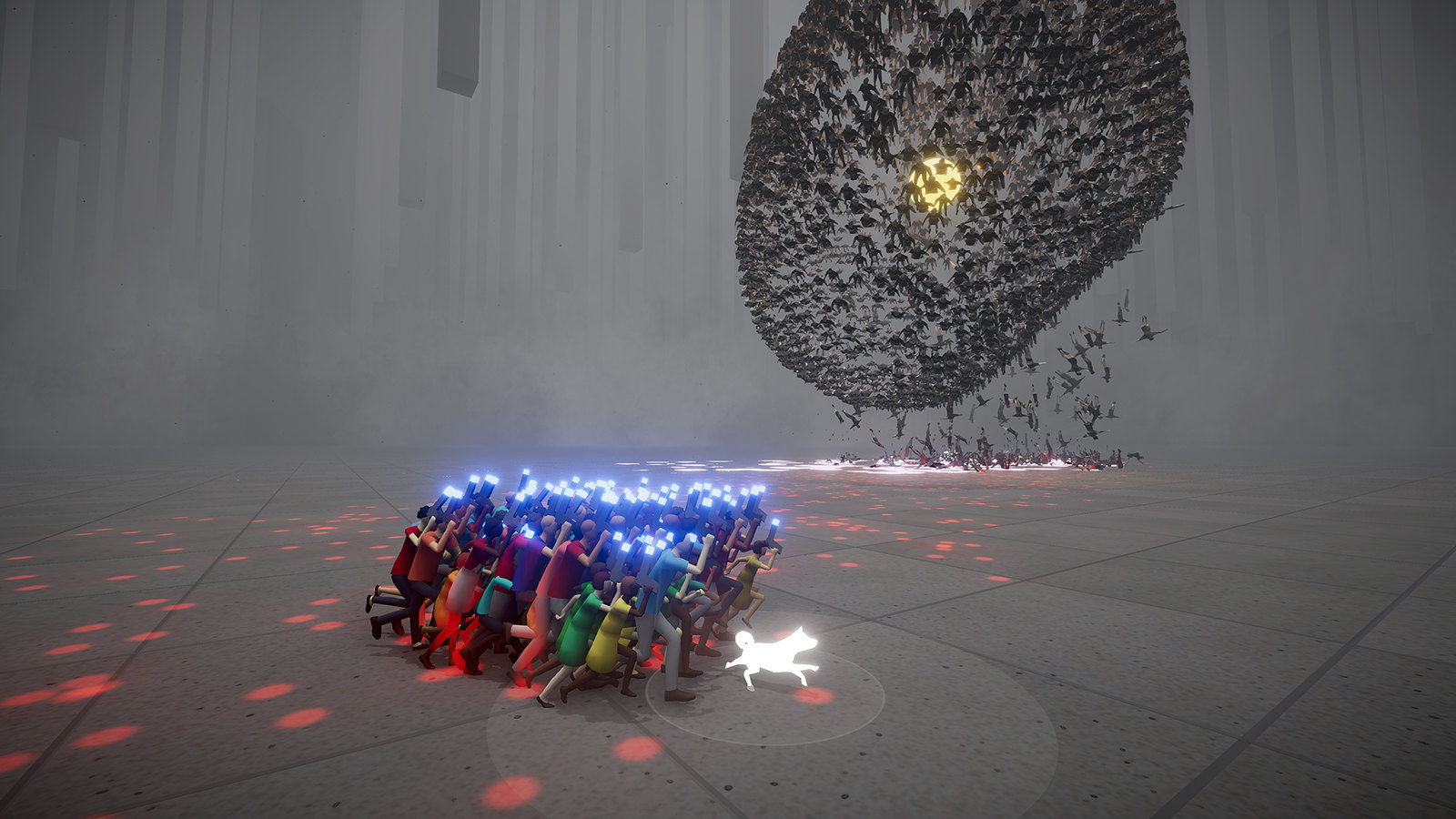Shuhei Yoshida
Curated From blog.playstation.com Check Them Out For More Content.
Shuhei Yoshida chats with Yugo Nakamura, creative director, art director, designer, and narrative designer for Humanity, and Tetsuya Mizuguchi, executive producer for Humanity, on how the title delivers a new puzzle game experience. They discuss the thought process behind the creation of Humanity as a new form of interactive experience and how they came up with the game’s main theme.
Humanity is available starting today as a Day 1 PlayStation Plus Game Catalog title.*

Inspired by the “flocking behavior of birds”
Shuhei Yoshida (SY): I heard that Nakamura-san likes to observe flocks of birds, and that’s where you found inspiration for Humanity. Can you tell us more about that?
Yugo Nakamura(YN): I specialize in Interactive Design, and I like to spend my time programming, sharing my work, and creating visual experiences; I enjoy these things and that’s why I do them for a living. I think a lot of people like me have used a simulation program called “Boids,” which essentially simulates the flocking behavior of birds. If you focus on just a single creature, you’re able to create very organic movements just by programming three simple rules and connecting them. But in the case of birds, the simulation looked so alive, and it was fascinating to see how organically the flock of birds moved, even though it was based on such a simple mechanism.
From there, I spent some time making a bite-size mobile game that used simple bird movements as motifs. It was like a racing game where you control a flock of birds.
SY: It’s the one where you try to progress further into the game, right?
YN: Yes. In a regular racing game, you’re only responsible for controlling one car, but in this game, you basically had to control 300 different cars. If you made a small mistake, you lost 100 birds, but then eventually gained back 200!
SY: Game developers like us are always looking to surprise people by creating something that goes above and beyond what you’d expect from a hardware’s capabilities. So when I saw your game, I felt something similar.
YN: I had similar thoughts as a consumer myself. I was shocked at how smoothly games ran back on the original PlayStation, and I thought that was such a great achievement. From there, I decided that since I already made a game with birds on a smartphone, next I wanted to create a system that controlled large groups of humans. That’s how the idea for Humanity was born.
SY: Birds’ movements are driven completely by instinct, but in the case of humans, a mix of intellect and social conventions come into play. What aspects did you focus on when designing the movement of crowds of humans?
YN: My first eureka moment was when I saw huge crowds of people at Comic Market (Comiket) in Japan, all properly lined up and waiting patiently. I was fascinated by how the movement of that many people was so controlled and regulated – I think this sort of behavior is unique to humans who are not just herded by instinct.
“Humanity is something special” – how development started
SY: How did you meet Mizuguchi-san?
YN: I’ve always loved games, and I’d seen Mizuguchi-san many times in gaming magazines since his time at Sega. I was a fan of his work. I once had a chance to meet him briefly, but then I saw him again at Unity Developer’s Delight – a developer event hosted by Unity. There, one of our engineers, Yama, showcased a human crowd simulator demo which was the prototype for Humanity. Mizuguchi-san was one of the judges there, and he later got in touch.
Tetsuya Mizuguchi (TM): I met Yugo once at the Japan Media Arts Festival, hosted by Japan’s Agency for Cultural Affairs, but to me he was like a superstar creator that produced so many unique and creative products. If you turned on the TV you’d see a show that he produced, and if you walked the streets of Ginza, you’d see UNIQLO ads that he had worked on.
Enhance helps navigate the complexities of game design
SY: Nakamura-san’s “tha ltd.” isn’t a game development studio. How does the collaboration between Enhance work?
YN: We aren’t a game studio, but our expertise lies in design and tech for interactive experiences. Even though we didn’t know much about video game design, we were overly optimistic at the beginning, and decided that our team will be responsible for development, and Enhance will take on the role of publisher and producer.
However, the deeper we went into development, we realized that game development was not at all like we had imagined. I realized rather early on that creating a fun gaming experience is not something an amateur can easily pull off, so I spoke to Mizuguchi-san to have seasoned game designers oversee our work. From there, we had staff from Enhance join our development as well.
The fun and terror of collectivized humanity
SY: I felt like the game’s title, Humanity, is ironic in a sense that it reflects how humanity as a concept can be perceived. Heaps of people walking around in hordes almost reminds me of a totalitarian society. I was really curious as to whether you developed the game with such irony in mind, or whether you were just genuinely interested in people. When creating a game, you have to implement a lot of rules, which may cause the game to end up becoming something that was not originally intended. Did you face any dilemma like that?
YN: Actually, the inspiration behind the game title is a T-shirt that I own with a logo that says “Humanity” – I thought that was a cool logo and the word itself had a nice ring to it. But when you think about it, Humanity has a very deep meaning, and when I reflected on how humanity plays a role in my daily life, many thoughts came to mind. Each and every one of us is generally kind and rational, and not many of us are inherently mad or crazy. However, this all changes drastically when it comes to ‘groups’. Politics, war, cancel culture on social media – people tend to go to extremes when they are part of a larger group. The title, Humanity, embodies the idea that humans gain a new trait when they come together.
When we view human beings as a cluster, and not as individuals, we may associate them with the totalitarian and homogenous image you mentioned earlier, and the fear and extremities that derive from that are certainly an important motif in the game.
SY: Visuals of the game evoke fear as well.
YN: It was even more terrifying and ruthless at the earlier stages. When you looked at a single human from a group’s perspective, they looked like a speck of dust or even a tiny piece of trash. Mizuguchi-san provided us with some guidance and we went in a more gentle direction.
Expanding the community with the Stage Creator
SY: What was the idea behind Stage Creator?
YN: Originally, the development team was working on a tool for level design, and we thought it would be fun to make it public. However, it was quite a challenge to develop it into something that users could play with a controller.
When we previously released the demo, I saw users creating stages that went far beyond our expectations, so I felt reassured that we made a good decision
SY: I felt the same with LittleBigPlanet and Dreams. It’s nice to see players leveraging the games in ways that the creators never imagined, and sharing their creations with other gamers. Humanity’s UI is also very well designed. Stages with high user ratings and recommendations are showcased at the top, allowing users to quickly discover fun and interesting community-made content.
The world of Humanity in PS VR2
SY: In my position, I must bring up the fact that the game is compatible with PS VR2. The team at Enhance has produced VR masterpieces such as Rez Infinite and Tetris Effect: Connected, so I imagine it was a familiar process for Mizuguchi-san. What was your impression of VR as a medium, Yugo?
YN: I enjoy VR so I have been playing around with it since the early days, but I had an impression that the majority of VR content was immersive first-person experiences. When Mizuguchi-san suggested trying out VR, I didn’t think it would be a good fit for this game, but there were so many discoveries when I gave it a try. I didn’t realize VR was capable of capturing extremely detailed 3D human movements in such high resolution. We were able to utilize VR in a unique way, where the player can watch over small crowds of people walking around in an elaborate diorama, as if you’re observing a swarm of ants.
TM: Most of the VR games I have worked on so far are immersive first-person experiences, but I had a feeling that Humanity would be interesting to play from a third-person perspective – sort of like Sim City where you can walk around and get a bird’s eye view of everything. At first, members of the team were a little skeptical, but when we tried it out, everyone agreed that it was a good idea. The development went smoothly from there.
SY: Performance, such as framerate, can be a concern on VR. Did you run into any issues around that?
YN: It was quite challenging optimizing for PS VR, but we had a lot of leeway with PS VR2. I think we were able to achieve the level of detail we were aiming for, with the resolution of the PS VR2.
Tetsuya Mizuguchi’s take on the potential of PS VR2
SY: As a developer, how do you feel about PS VR2 overall – not just limited to Humanity?
TM: Compared to the original PS VR, the overall quality has improved dramatically, and I think it is an amazing generational leap forward. As a developer, I’m particularly interested and see a lot of potential in the new eye tracking feature.
Also, you may think that we at Enhance are obsessed with haptics – well, we are haha – but we are interested in building experiences that involve haptics. In that sense, the inclusion of haptic feedback in the headset is very significant. What I found out when I created the Synesthesia Suit for Rez Infinite, for example, is that when there is distance, you can experience the world through the senses of your whole body. You can feel the sensation of objects passing by or the alternating beat of the music. What only existed in the palm of your hands is now extended to the headset, so there are so many new possibilities.
A perfect chemistry of puzzles and narrative that make it worth playing till the end
SY: It’s been five years since development started. How do you feel looking back?
YN: We were struggling the whole time basically (haha). I mentioned earlier that the game was an extension of an interactive design we worked on, and there were parts of the process that were exactly as we had imagined and parts that were completely unexpected. The basic aspects of development were what we had expected, but the process of refining the game to make it more fun and enjoyable was very unique.
Extensive playtesting and listening to various user feedback is common practice in the game industry. Even when there were opinions I thought were okay to ignore, we diligently repeated the process of resolving them. We would eliminate even the slightest stress, and the end result would be a game that is pleasant and comfortable to play, even if you can’t quite complete it.
SY: Indeed, there is no stress when playing Humanity. You can retry immediately if you fail, and it drops you right back into the middle of what you have been doing. I felt that the game was being accommodating to the user and made them feel comfortable during gameplay.Players from around the globe enjoyed the demo released in February, and now the full version is available as part of the PlayStation Plus Game Catalog.How do you feel about that?
YN: In one word, I am terrified! The content I usually produce lasts five to 15 minutes at most. With videos, I only need to grab the attention of the viewer for that short amount of time, so I can focus on that and make it happen. Games, however, can take up to several tens of hours, so I cannot help but wonder if our game is really worth that amount of players’ time. As the creator, I don’t have that much objective confidence, and because I’ve been a part of the game’s development for so long I can’t say I’m objective anymore.
SY: Do you have a message for those who haven’t played Humanity yet?
YN: There may be people who don’t enjoy puzzles or are not too fond of it as a game genre, but I hope people will see past that and give it a try. Of course the puzzles are fun, but I encourage gamers to jump in and play around as if it’s a playground; move the crowds in various ways and experiment by making them do different things. You’ll see a lot of interesting behaviors and results. We put work in creating a game that you won’t get tired of.
It is part of the PlayStation Plus Game Catalog, so if you are already a member, you can play it whenever you feel like it. I’ll be delighted if everyone could give it a try.
TM: Humanity is a game that delivers a whole new experience. If you ask me what genre it is, I would probably say it is a puzzle game. I think it is easy enough for anyone to pick up – from children to the elderly, even our parents’ generation. Everything that happens is a spectacle, and that alone is interesting, but I think the game is about experiencing the narrative, and immersing yourself in the story of Humanity.
It’s a fun game that can be enjoyed on your own, or have family and friends with you helping to solve the puzzles. You can also treat it like a party game where everyone beats the game together. I hope players enjoy the game in their own way, and are able to witness the end that we prepared for them.
*Humanity is available now on PS4, PS5, PS VR, and PS VR2. It’s also included with the PlayStation Plus Game Catalog with PlayStation Plus Extra and PlayStation Plus Premium memberships.







